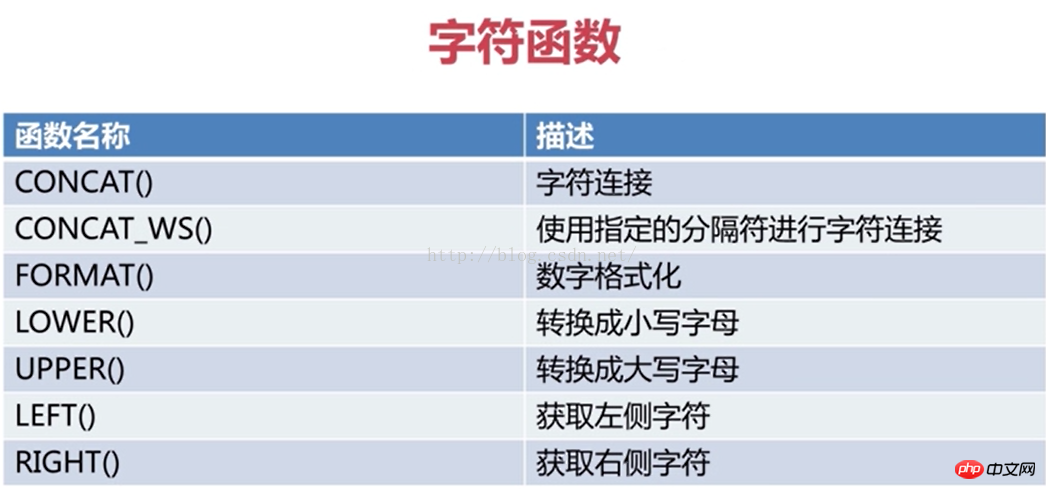


#CONCAT() and CONCAT_WS() character connection
mysql> SELECT CONCAT('mysql','5.6'); +-----------------------+ | CONCAT('mysql','5.6') | +-----------------------+ | mysql5.6 | +-----------------------+ 1 row in set (0.09 sec) mysql> SELECT CONCAT('mysql','-','5.6'); +---------------------------+ | CONCAT('mysql','-','5.6') | +---------------------------+ | mysql-5.6 | +---------------------------+ 1 row in set (0.00 sec)
mysql> SELECT * FROM tdb_test; +----+------------+-----------+ | id | first_name | last_name | +----+------------+-----------+ | 1 | A | B | | 2 | Jack | Bob | | 3 | tom% | 123 | +----+------------+-----------+ 3 rows in set (0.00 sec) mysql> SELECT CONCAT(first_name,last_name) AS fullname FROM tdb_test; +----------+ | fullname | +----------+ | AB | | JackBob | | tom%123 | +----------+ 3 rows in set (0.00 sec)
mysql> SELECT CONCAT_WS('|','A','B','C'); +----------------------------+ | CONCAT_WS('|','A','B','C') | +----------------------------+ | A|B|C | +----------------------------+ 1 row in set (0.00 sec) mysql> SELECT CONCAT_WS('-','mysql','5.6'); +------------------------------+ | CONCAT_WS('-','mysql','5.6') | +------------------------------+ | mysql-5.6 | +------------------------------+ 1 row in set (0.00 sec)
FORMAT() number formatting
mysql> SELECT FORMAT(12560.75,1); +--------------------+ | FORMAT(12560.75,1) | +--------------------+ | 12,560.8 | +--------------------+ 1 row in set (0.01 sec) LOWER()和 UPPER() mysql> SELECT LOWER('MySql'); +----------------+ | LOWER('MySql') | +----------------+ | mysql | +----------------+ 1 row in set (0.00 sec) mysql> SELECT UPPER('MySql'); +----------------+ | UPPER('MySql') | +----------------+ | MYSQL | +----------------+ 1 row in set (0.00 sec)
LEFT() and RIGHT()
have two parameters respectively. The first one is the string used, and the second one is the numberFor example, get the first two digits of MySQLmysql> SELECT LEFT('MySQL',2); +-----------------+ | LEFT('MySQL',2) | +-----------------+ | My | +-----------------+ 1 row in set (0.00 sec)
mysql> SELECT RIGHT('MySQL',2); +------------------+ | RIGHT('MySQL',2) | +------------------+ | QL | +------------------+ 1 row in set (0.00 sec)
LENGTH Get the string length
mysql> SELECT LENGTH('MySQL'); +-----------------+ | LENGTH('MySQL') | +-----------------+ | 5 | +-----------------+ 1 row in set (0.02 sec)
LTRIM,RTRIM,TRIM
For example, directly use SELECT TRIM( ' mysql '); will delete the spaces before and after mysql, LTRIM only deletes the spaces on the left, and RTRIM only deletes the spaces on the right.mysql> SELECT TRIM(LEADING '?' FROM '??MySQL???'); +-------------------------------------+ | TRIM(LEADING '?' FROM '??MySQL???') | +-------------------------------------+ | MySQL??? | +-------------------------------------+ 1 row in set (0.02 sec) mysql> SELECT TRIM(TRAILING '?' FROM '??MySQL???'); +--------------------------------------+ | TRIM(TRAILING '?' FROM '??MySQL???') | +--------------------------------------+ | ??MySQL | +--------------------------------------+ 1 row in set (0.00 sec) mysql> SELECT TRIM(BOTH '?' FROM '??MySQL???'); +----------------------------------+ | TRIM(BOTH '?' FROM '??MySQL???') | +----------------------------------+ | MySQL | +----------------------------------+ 1 row in set (0.01 sec)
REPLACE() string replacement
For example, replace the ? in ??My??SQL??? Replace it with emptymysql> SELECT REPLACE('??My??SQL???','?',''); +--------------------------------+ | REPLACE('??My??SQL???','?','') | +--------------------------------+ | MySQL | +--------------------------------+ 1 row in set (0.00 sec)
, intercepts from which number, intercepts which number .
mysql> SELECT SUBSTRING('MySQL',1,2); +------------------------+ | SUBSTRING('MySQL',1,2) | +------------------------+ | My | +------------------------+ 1 row in set (0.00 sec)
It should be noted that, unlike programming languages, the first bit is 1, not 0.
If you only start from the number and don't intercept a few, it will be intercepted until the end.
mysql> SELECT SUBSTRING('MySQL',3); +----------------------+ | SUBSTRING('MySQL',3) | +----------------------+ | SQL | +----------------------+ 1 row in set (0.00 sec)
The position can also be a negative value (counting backwards)
mysql> SELECT SUBSTRING('MySQL',-1); +-----------------------+ | SUBSTRING('MySQL',-1) | +-----------------------+ | L | +-----------------------+ 1 row in set (0.04 sec)
Note, it can only be the beginning The position can have negative values, but the interception length cannot have negative values.
mysql> SELECT 'MySQL' LIKE 'M%';
+-------------------+
| 'MySQL' LIKE 'M%' |
+-------------------+
| 1 |
+-------------------+
1 row in set (0.00 sec)
% refers to any one or more digits
mysql> SELECT * FROM tdb_test; +----+------------+-----------+ | id | first_name | last_name | +----+------------+-----------+ | 1 | A | B | | 2 | Jack | Bob | | 3 | tom% | 123 | +----+------------+-----------+ 3 rows in set (0.00 sec)
For example, query, users whose names contain o
mysql> SELECT * FROM tdb_test WHERE first_name LIKE '%o%'; +----+------------+-----------+ | id | first_name | last_name | +----+------------+-----------+ | 3 | tom% | 123 | +----+------------+-----------+ 1 row in set (0.00 sec)
For example, query, users whose names contain %
mysql> SELECT * FROM tdb_test WHERE first_name LIKE '%%%'; +----+------------+-----------+ | id | first_name | last_name | +----+------------+-----------+ | 1 | A | B | | 2 | Jack | Bob | | 3 | tom% | 123 | +----+------------+-----------+ 3 rows in set (0.00 sec)
发现显示的是所有查询结果。因为mysql会认为上述的%都为通配符。正确操作如下
mysql> SELECT * FROM tdb_test WHERE first_name LIKE '%1%%' ESCAPE '1'; +----+------------+-----------+ | id | first_name | last_name | +----+------------+-----------+ | 3 | tom% | 123 | +----+------------+-----------+ 1 row in set (0.00 sec)
注:%:任意个字符.
_:任意一个字符。
以上就是MySQL字符函数的详细介绍的内容,更多相关内容请关注PHP中文网(www.php.cn)!




